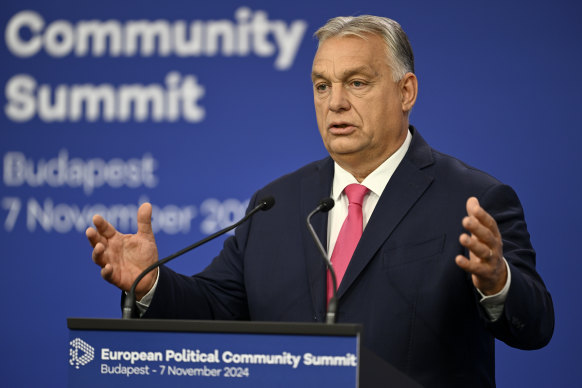

But, he added, “We have this system now. And this is important.”
Testing the missile will continue, Putin said, “including in combat, depending on the situation and the character of security threats created for Russia”. He noted there is “a stockpile of such systems ready for use”.
The missile prompts the closing of Ukrainian Parliament.Credit: AP
Putin said that while it isn’t an intercontinental missile, it is so powerful that the use of several of them fitted with conventional warheads in one attack could be as devastating as a strike with strategic – or nuclear – weapons.
General Sergei Karakayev, head of Russia’s strategic missile forces, said the Oreshnik could reach targets across Europe and be fitted with nuclear or conventional warheads, echoing Putin’s claim that even with conventional warheads, “the massive use of the weapon would be comparable in effect to the use of nuclear weapons”.
Kremlin spokesman Dmitry Peskov kept up Russia’s bellicose tone on Friday, blaming “the reckless decisions and actions of Western countries” in supplying weapons to Ukraine to strike Russia.

Hungary’s Prime Minister Viktor Orban.Credit: AP
“The Russian side has clearly demonstrated its capabilities, and the contours of further retaliatory actions in the event that our concerns were not taken into account have also been quite clearly outlined,” he said.
Hungarian Prime Minister Viktor Orban, widely seen as having the warmest relations with the Kremlin in the European Union, echoed Moscow’s talking points, suggesting the use of US-supplied weapons in Ukraine likely requires direct American involvement.
“These are rockets that are fired and then guided to a target via an electronic system, which requires the world’s most advanced technology and satellite communications capability,” Orban said on state radio. “There is a strong assumption … that these missiles cannot be guided without the assistance of American personnel.”
Orban cautioned against underestimating Russia’s responses, emphasising that the country’s recent modifications to its nuclear deployment doctrine should not be dismissed as a “bluff.”
Loading
“It’s not a trick … there will be consequences,” he said.
Separately in Kyiv, Czech Foreign Minister Jan Lipavsky called Thursday’s missile strike an “escalatory step and an attempt of the Russian dictator to scare the population of Ukraine and to scare the population of Europe”.
At a news conference with Ukrainian Foreign Minister Andrii Sybiha, Lipavsky also expressed his full support for delivering the necessary additional air defence systems to protect Ukrainian civilians from the “heinous attacks”.
He underlined that the Czech Republic will impose no limits on the use of its weapons and equipment given to Ukraine.
Three lawmakers from Ukraine’s parliament, the Verkhovna Rada, confirmed that Friday’s previously scheduled session was called off due to the ongoing threat of Russian missiles targeting government buildings in central Kyiv.
There was also a recommendation to limit the work of all commercial offices and non-governmental organisations “in that perimeter, and local residents were warned of the increased threat,” said lawmaker Mykyta Poturaiev, who added this is not the first time such a threat has been received.
President Volodymyr Zelensky’s office continued to work in compliance with standard security measures, a spokesperson said.
Ukraine’s Main Intelligence Directorate said the Oreshnik missile, whose name in Russian means “hazelnut tree,” was fired from the Kapustin Yar 4th Missile Test Range in Russia’s Astrakhan region, and flew 15 minutes before striking Dnipro.
Test launches of a similar missile were conducted in October 2023 and June 2024, the directorate said. The Pentagon confirmed the missile was a new, experimental type of intermediate-range missile based on its RS-26 Rubezh intercontinental ballistic missile.
Thursday’s attack struck the Pivdenmash plant that built ICBMs when Ukraine was part of the Soviet Union. The military facility is located about 6½ kilometres south-west of the centre of Dnipro, a city of about 1 million that is Ukraine’s fourth-largest and a key hub for military supplies and humanitarian aid. It is also home to one of the country’s largest hospitals for treating wounded soldiers from the front before their transfer to Kyiv or abroad.
Get a note directly from our foreign correspondents on what’s making headlines around the world. Sign up for the weekly What in the World newsletter here.




